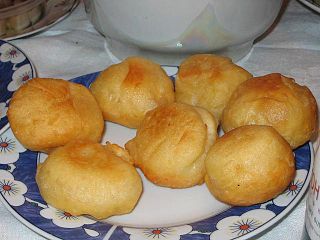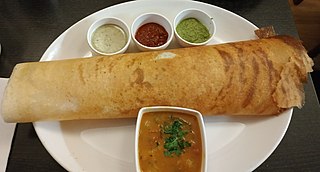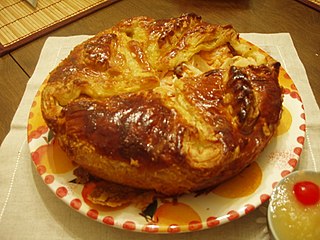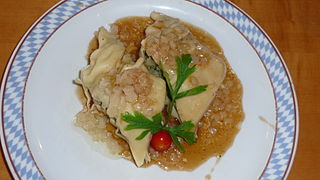
A dosa, dosey, dosai, dosha is a thin, savoury crepe in Indian cuisine made from a fermented batter of ground black gram and rice. Dosas are served hot, often with chutney and sambar. Dosas are a common food in South India and North Sri Lanka.

Pampúshka is a small savory or sweet yeast-raised bun or doughnut typical for Ukrainian cuisine.

Sri Lankan cuisine is known for its particular combinations of herbs, spices, fish, vegetables, rices, and fruits. The cuisine is highly centered around many varieties of rice, as well as coconut which is a ubiquitous plant throughout the country. Seafood also plays a significant role in the cuisine, be it fresh fish or preserved fish. As a country that was a hub in the historic oceanic silk road, contact with foreign traders brought new food items and cultural influences in addition to the local traditions of the country's ethnic groups, all of which have helped shape Sri Lankan cuisine. Influences from Indian, Indonesian and Dutch cuisines are most evident with Sri Lankan cuisine sharing close ties to other neighbouring South and Southeast Asian cuisines.

Rajasthani cuisine is the traditional cuisine of the Rajasthan state in north-west India. It was influenced by various factors like the warlike lifestyles of its inhabitants, the availability of ingredients in an arid region and by Hindu temple traditions of sampradayas like Pushtimarg and Ramanandi. Food that could last for several days and could be eaten without heating was preferred.

Puri, also poori, is a type of deep-fried bread, made from unleavened whole-wheat flour, originated from the Indian subcontinent.

Puran poli is an Indian sweet flatbread that is popular in South India and the state of Maharashtra. It is also known as puran puri, holige, obbattu, bobbatlu, poley, bakshamulu, and boli.

An appam or hoppers is a type of thin pancake originating from South India and Sri Lanka. It is made with fermented rice batter and coconut milk, traditionally cooked in an appachatti, a deep pan similar in shape to a wok. It is part of Tamil cuisine and Kerala cuisine found in the Indian states of Tamil Nadu and Kerala, and in Sri Lanka. Appam is most frequently served for breakfast or dinner, often with a topping such as an egg.

Indian breads are a wide variety of flatbreads and crêpes which are an integral part of Indian cuisine. Their variation reflects the diversity of Indian culture and food habits.
Kluski is a generic Polish name for all kinds of soft dumplings, usually without a filling.
The North Indian state of Himachal Pradesh is a state that has remained largely uninfluenced by Western culture. Himachal Pradesh is a multi-religion practising, multicultural and multilingual state. Some of the most commonly spoken languages are Hindi and the various Pahari languages. The Hindu communities residing in Himachal include the Brahmins, Rajputs, Kannets, Rathis and Kolis. There is also a tribal population in the state which mainly comprises Gaddis, Kinnarms, Gujjars, Pangawals and Lahaulis.

Lahoh, is a spongy, flat pancake-like bread. It is a type of flatbread eaten regularly in Somalia, Djibouti, Kenya, Ethiopia, Yemen and Saudi Arabia. Yemenite Jewish immigrants popularized the dish in Israel. It is called canjeero/canjeelo in southern Somalia and also called laxoox/lahoh in Somaliland, Djibouti, Yemen and Saudi Arabia, respectively.

Pirog is a baked case of dough with either sweet or savory filling. The dish is common in Eastern European cuisines.

Changzhou sesame cake is a type of elliptical, baked cake that originated in Changzhou, Jiangsu supposedly over 150 years ago. Cakes are formed through several layers of yeast-fermented dough separated by lard that are flattened, stuffed, and baked with a coating of sesame seeds. Commonly eaten as a breakfast food with congee or as a street snack, they are now often bought prepackaged and given as gifts.

A food paste is a semi-liquid colloidal suspension, emulsion, or aggregation used in food preparation or eaten directly as a spread. Pastes are often highly spicy or aromatic, are often prepared well in advance of actual usage, and are often made into a preserve for future use. Common pastes are some fruit preserves, curry pastes, and nut pastes. Purées are food pastes made from already cooked ingredients.

Swabian cuisine is native to Swabia, a region in southwestern Germany comprising great parts of Württemberg and the Bavarian part of Swabia. Swabian cuisine has a reputation for being rustic, but rich and hearty. Fresh egg pastas, soups, and sausages are among Swabia's best-known types of dishes, and Swabian cuisine tends to require broths or sauces; dishes are rarely "dry".

Dumpling is a broad class of dishes that consist of pieces of cooked dough, often wrapped around a filling. The dough can be based on bread, wheat or other flours, or potatoes, and it may be filled with meat, fish, tofu, cheese, vegetables, or a combination. Dumplings may be prepared using a variety of cooking methods and are found in many world cuisines.

Mangalore Buns is a deep-fried bread originating from the Udupi-Mangalore region of Karnataka, India, and part of Mangalorean cuisine or Udupi cuisine. It is a popular snack and breakfast item, now popular all over the state. The buns are mildly sweet, soft and fluffy puri-like deep-fried bread, primarily made of all purpose flour and banana.

Pampuchy are a type of steamed yeast dumpling (kluski) or doughnut (pączek) in Polish cuisine. A cooked pampuch (sing.) has an oval, flat on the bottom shape, with a bouncy, mushy and soft consistency. Pampuchy or bułki na parze are served hot: either sweet or savoury.

Arab Indonesian cuisine is characterized by the mixture of Middle Eastern cuisine with local Indonesian-style cuisine. Arab Indonesians brought their legacy of Arab cuisine—originally from Hadhramaut, Hejaz, Sudan and Egypt—and modified some of the dishes with the addition of Indonesian ingredients. The Arabs arrived in the Nusantara archipelago to trade and spread Islam. In Java, since the 18th century AD, most of Arab traders settled on the north coast and diffuse with indigenous, thus affecting the local cuisine culture, especially in the use of goat and mutton meat as well as ghee in cooking.

Pahari culture refers to the cultural practices, traditions, arts, languages, lifestyles, and social behavior of the people living in the hilly regions of northern India, Pakistan, and Nepal. The term "pahari" or "pahadi" originates from the Hindi word "pahad", denotes "mountain" or "hill", and collectively describes the inhabitants of mountainous areas, including parts of Himachal Pradesh, Jammu and Kashmir, Uttarakhand, and northern Pakistan, as well as the Himalayan foothills in Nepal.


















